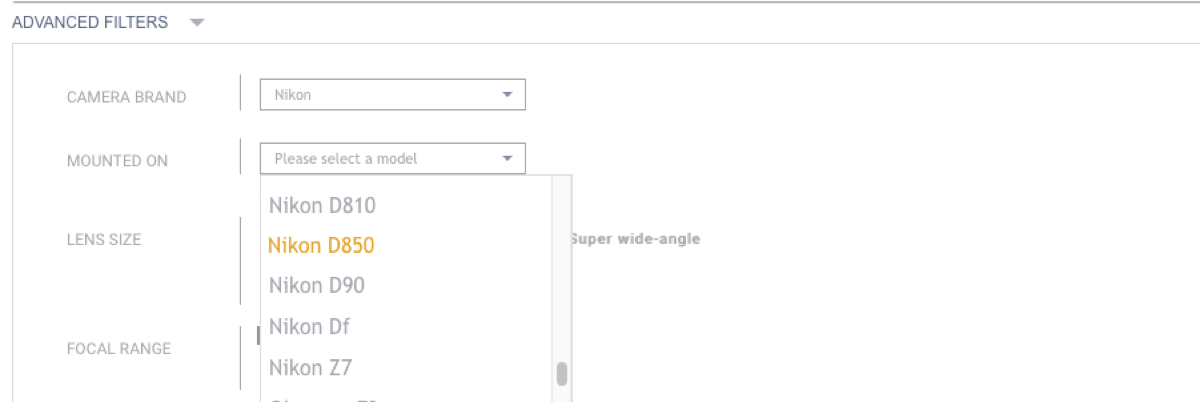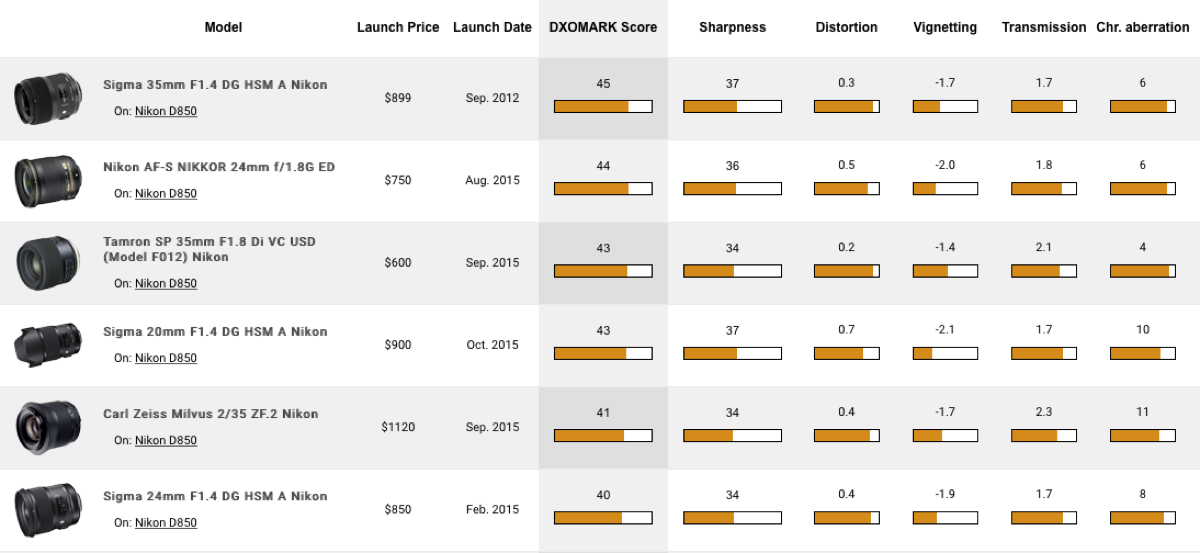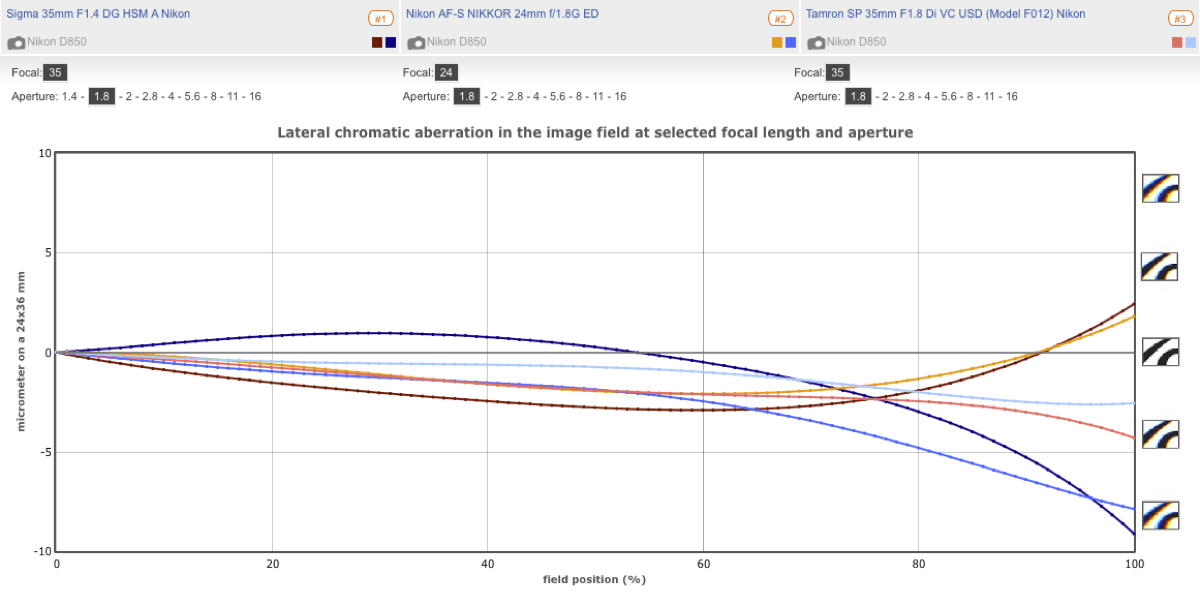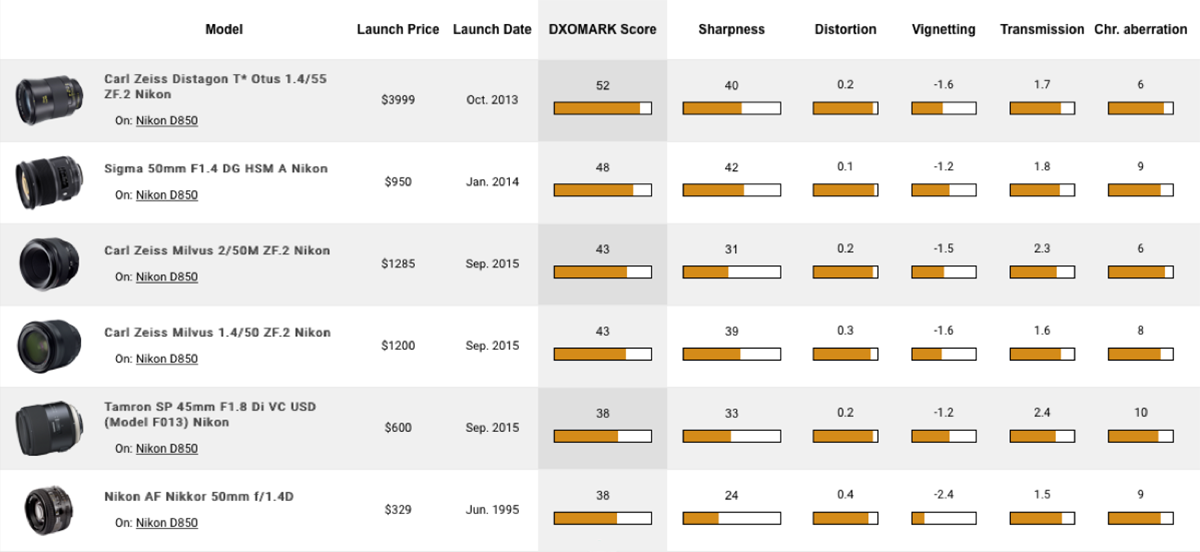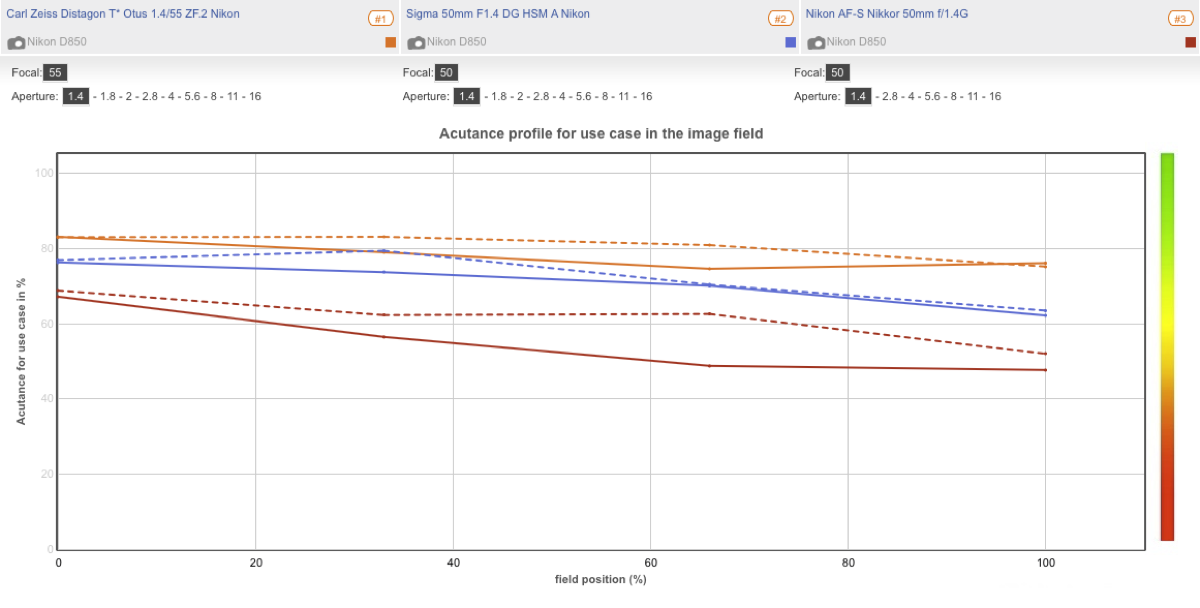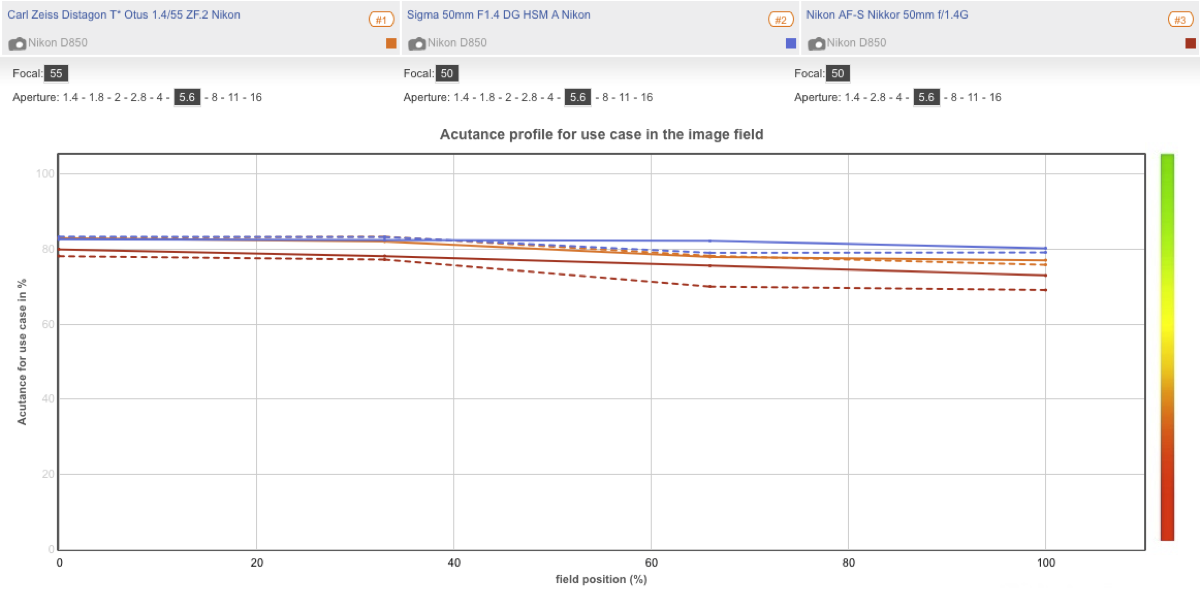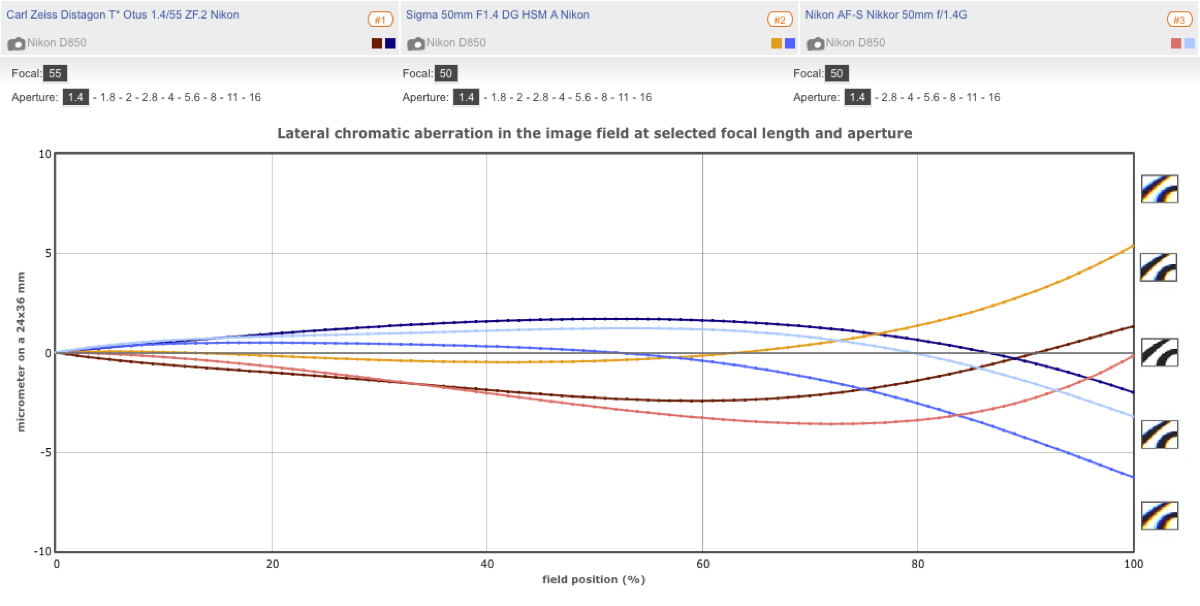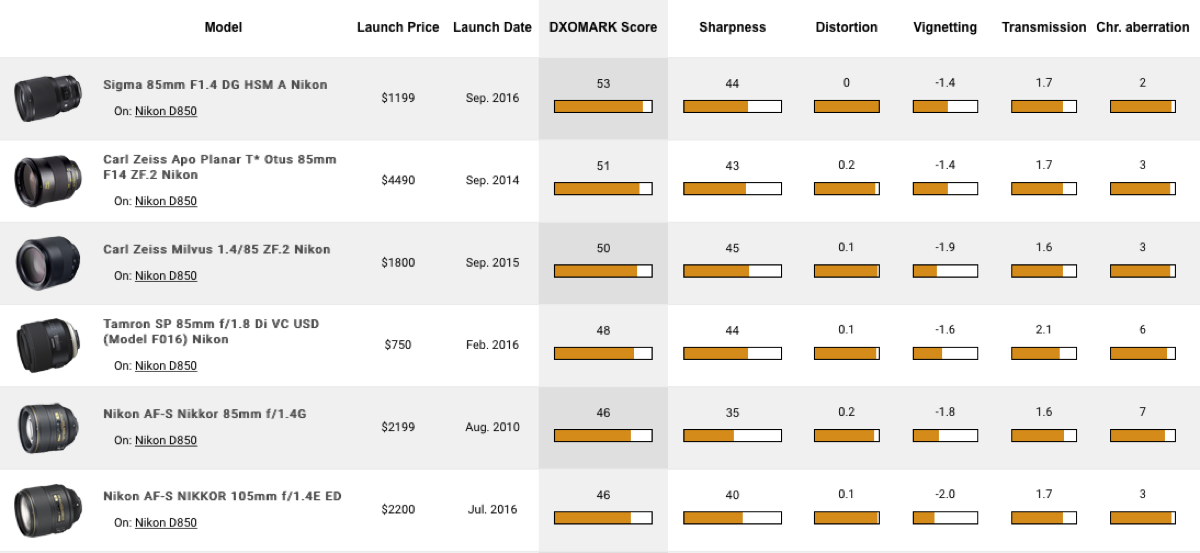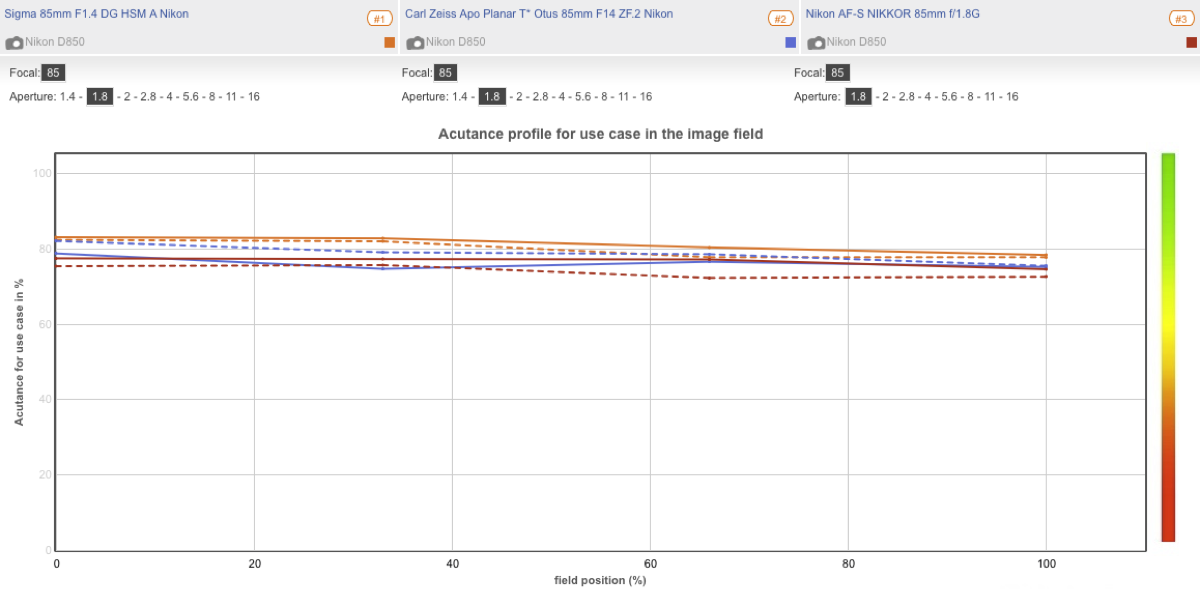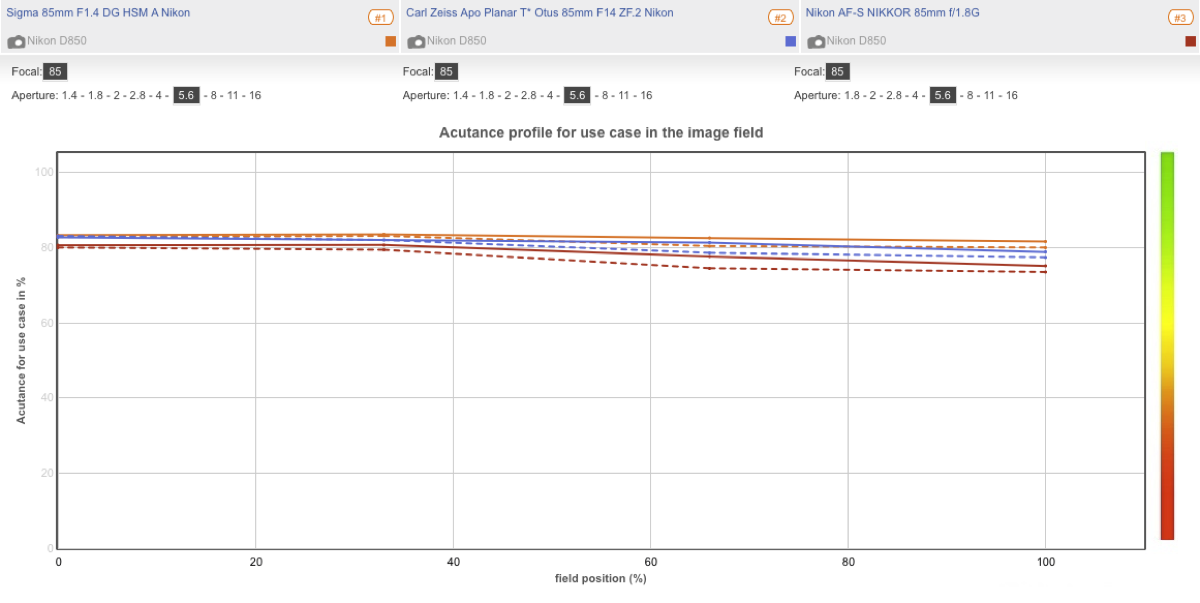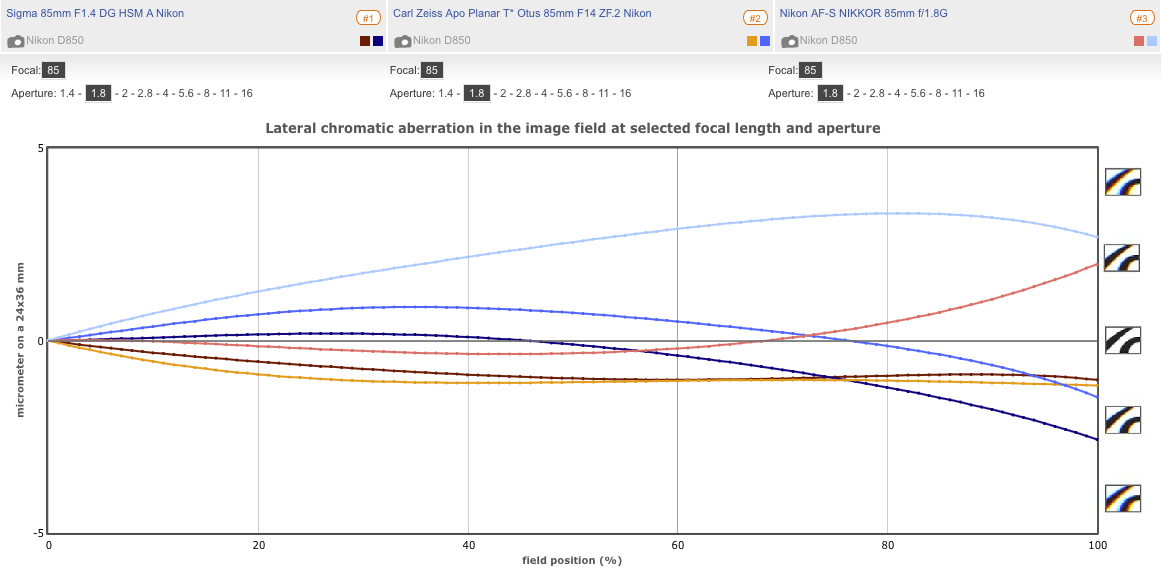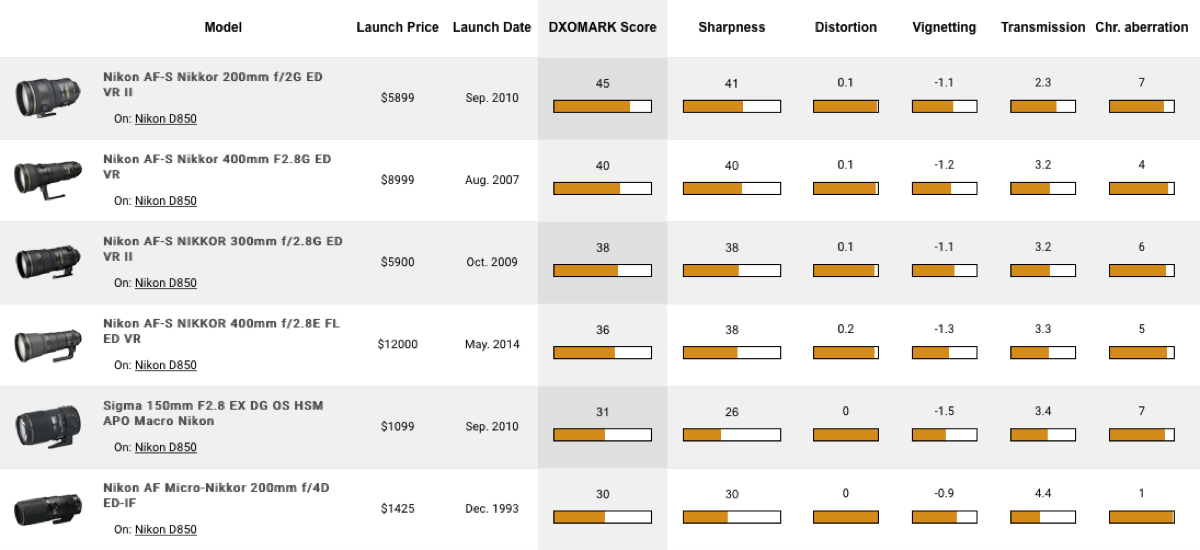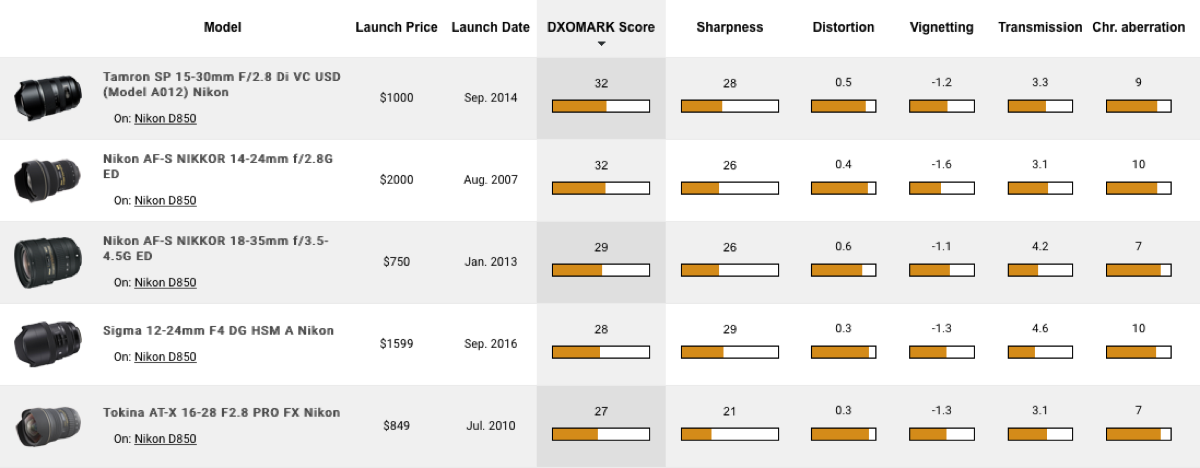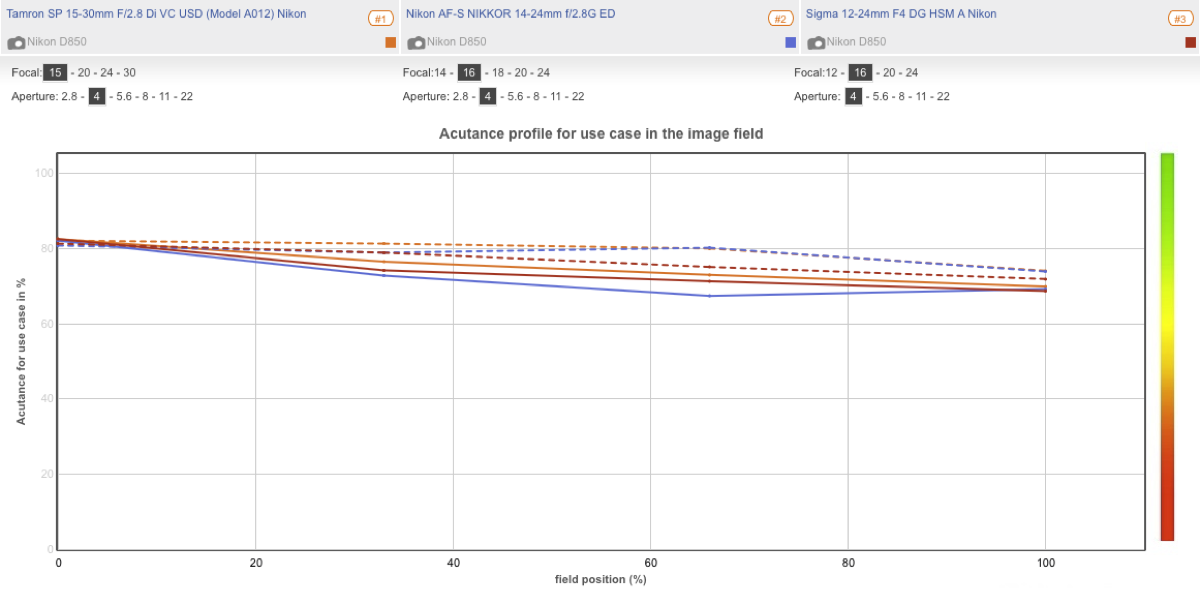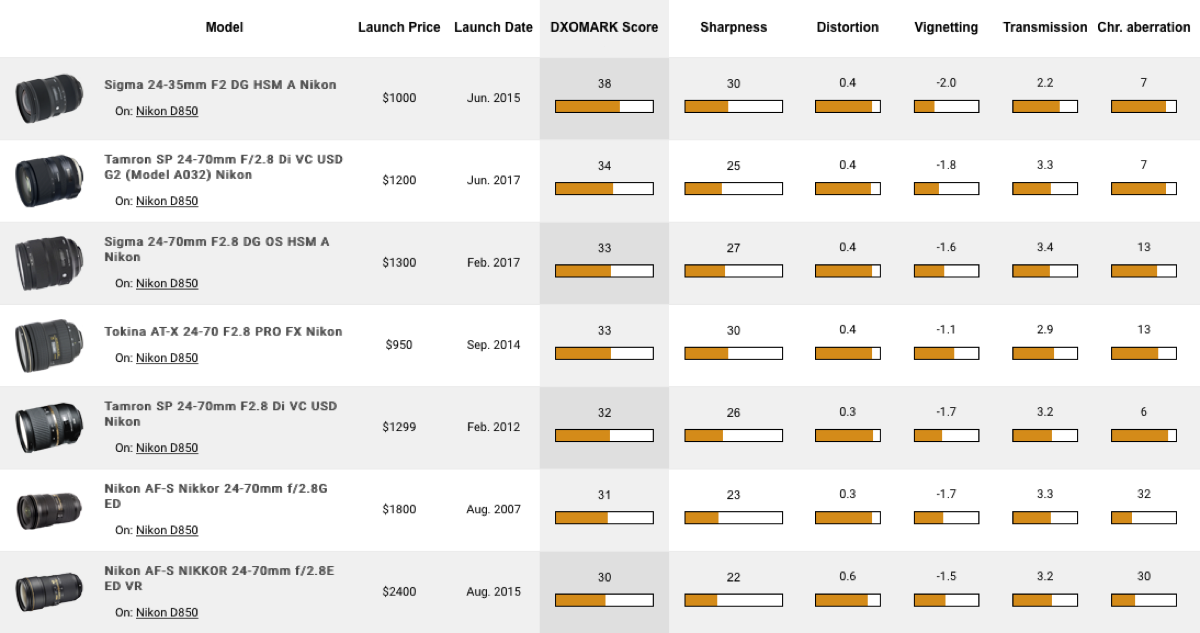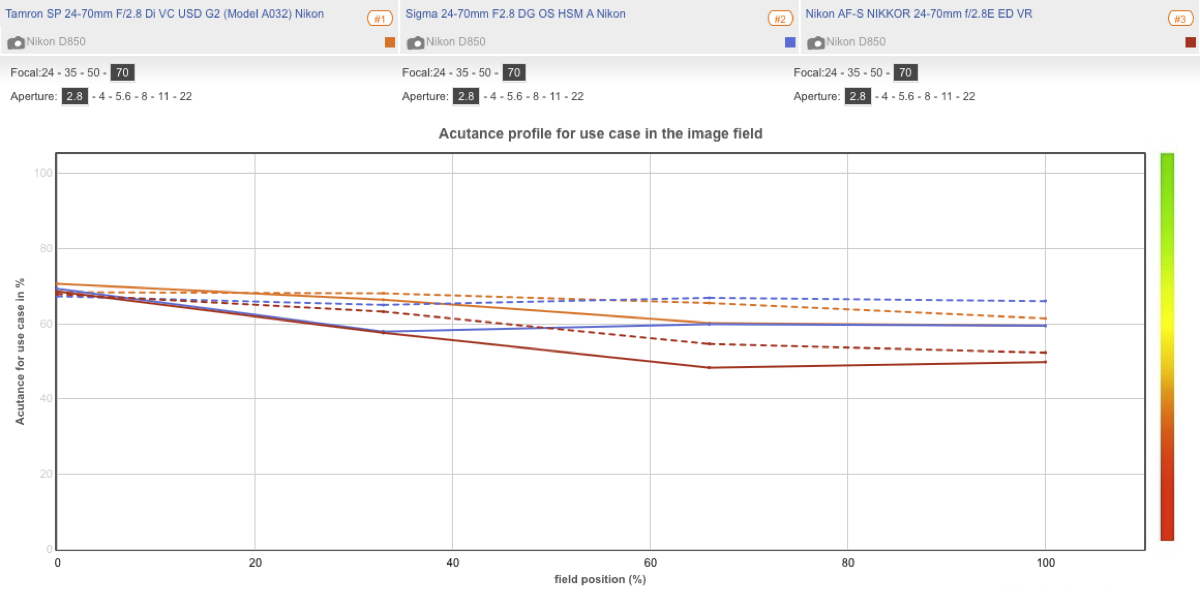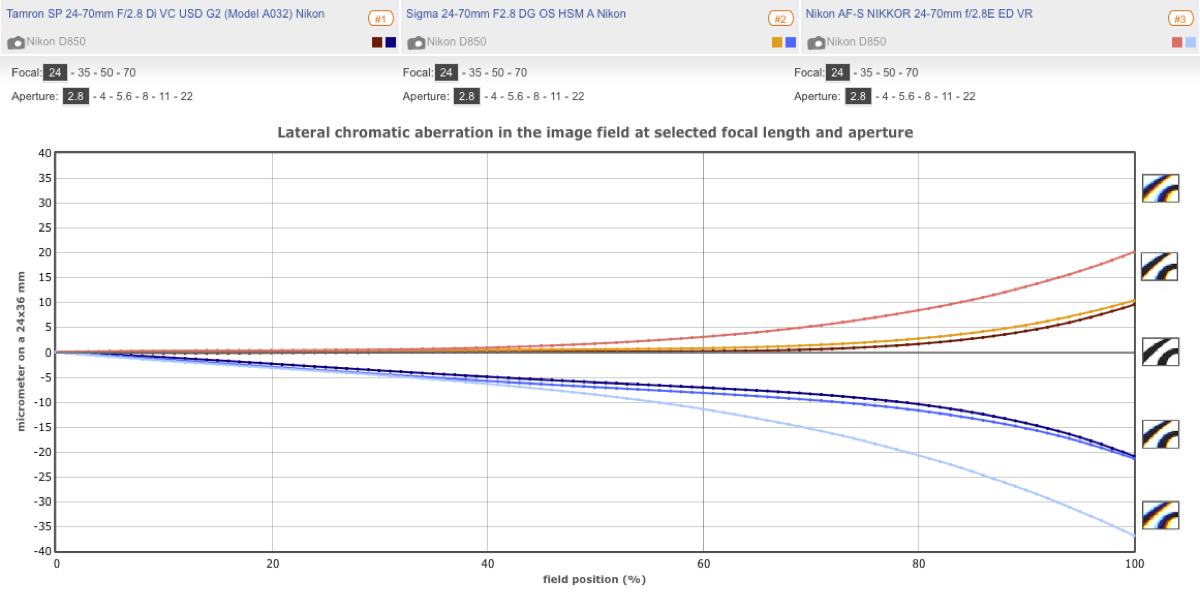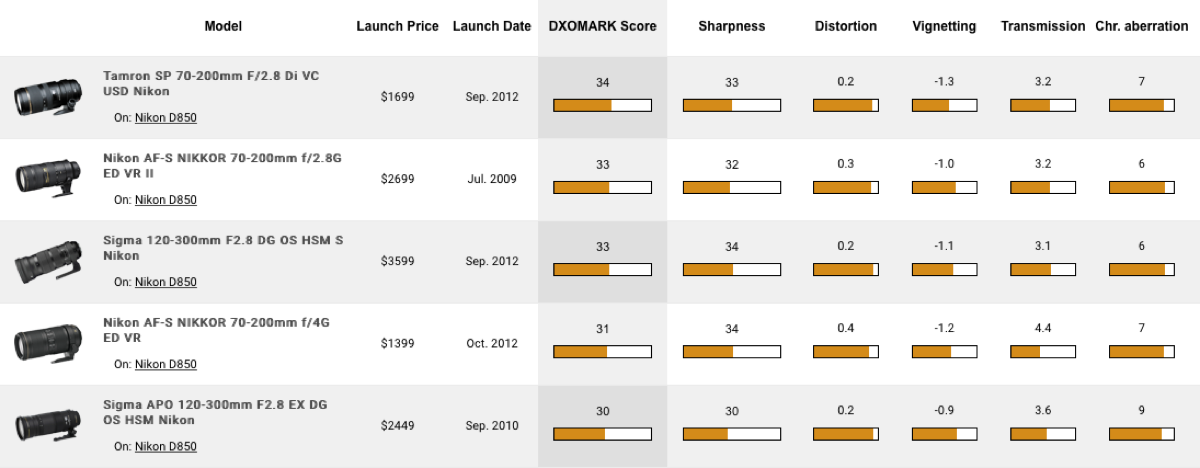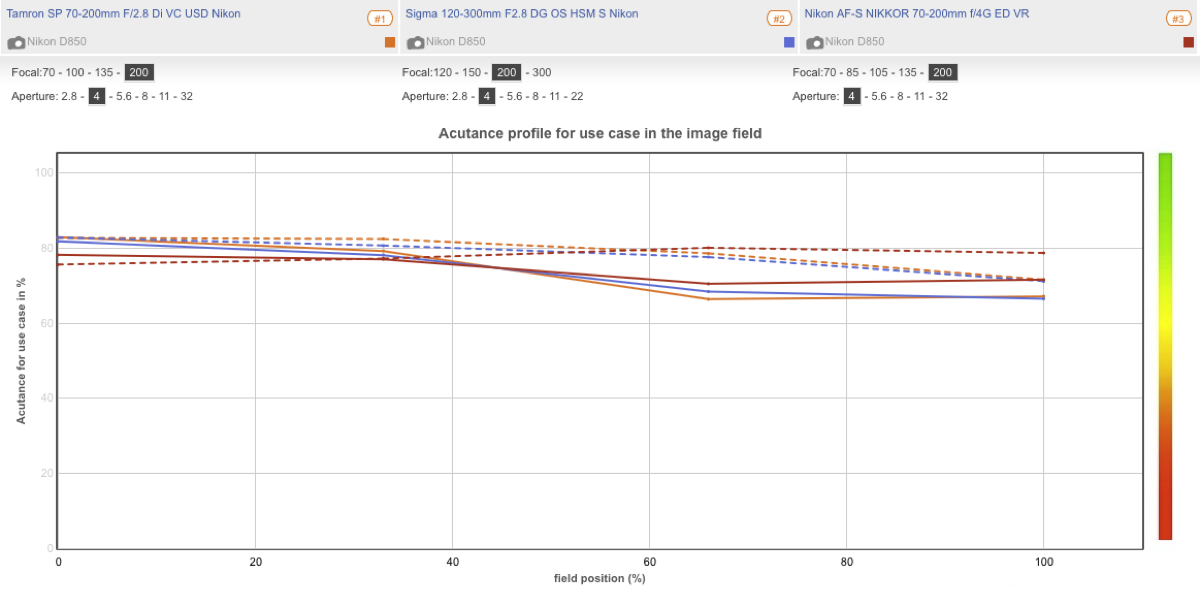In October 2017—Nikon’s 100th anniversary year—we published our Nikon D850 sensor review. The D850 scored an excellent 100 points, the first full-frame 35mm sensor to reach 100, which secured its number one position in our Sensor performance ranking at the time for that size sensor. For this article, we measured the results for a total of 128 Nikon F-mount compatible lenses on the Nikon D850, and you can now select that camera as an option when browsing our lens database and making your own comparisons.
The list includes prime and zoom lenses from Nikon, Sigma, Zeiss, Tamron, and Tokina, and covers focal lengths from 12 to 600mm. We have separated the primes from the zooms in the following sections and categorized them into wide-angle, standard, short-telephoto, and telephoto lenses. Broken down like this, it will hopefully give you a clearer idea of which lenses work best on the Nikon D850 and guide you in finding the right lens for your style of photography.
Prime lenses
We’ve updated the optical performance data on a total of 78 prime lenses based specifically on the 45.7MP Nikon D850 sensor. The best performers are the Sigma 85mm F1.4 DG HSM A, with an excellent 53 points, and the Zeiss Otus 1.4/55 ZF.2 with 52. These are, incidentally, also the highest system (lens and camera) ratings we’ve seen in our database. However, in terms of the Perceptual MPix rating, when coupled with the best-performing lenses for it, the Sony A7R IV remains the leader. Nikon lenses performed very well, too, making them perfect partners for the D850—though as you will see, Nikon has lost some ground in recent years to third parties. Let’s have a look at all the categories.
Wide-angle primes
This sample range is very extensive, as we’ve combined wide and ultra-wide in this category; still, you can easily compare your own group of lenses. In first place with a DXOMARK score of 45 on the Nikon D850 is the $899 Sigma F1.4 Art. While relatively affordable, the top six range from $600 to over $1100 (at introduction). Generally speaking, newer Nikkor lenses occupy better positions in our league tables, with the $750 AF-S Nikkor 24mm F1.8G coming in second place, albeit with a similar overall score. In third place is another 35mm—though this time from Tamron, and it’s the most affordable of the group. Also worth a mention are two other Sigmas—the 20mm F1.4 and the 24mm F1.4, at $900 and $850, respectively; both offer exceptional performance, with the benefit of ultra-fast maximum apertures.
All three share very similar sharpness profiles where aperture values overlap. As the fastest lens of the three, the Sigma is surprisingly sharp. Even wide open, it’s as sharp as the other two at their maximum apertures, and at f/1.8, the Sigma is slightly sharper—at least in the center. Sharpness falls away from the center as it does with the other two, but the other two don’t exhibit the astigmatism of the Sigma. It’s relatively mild, but it’s there throughout the aperture range to f/8. Despite the Tamron having more homogenous sharpness, it never quite equals the Sigma in the outer zones, although it is a match centrally. The Nikkor also has high central sharpness; in fact, it’s as sharp as the others, albeit with some slight astigmatism.
As you might expect given the shorter focal length, the Nikkor has more distortion than the 35mms and it has marginally more vignetting. It also has similar levels of lateral chromatic aberration, which is low and very well controlled throughout the aperture range. Given its short focal length and wide maximum aperture, it’s an excellent performer, but then again, each lens is in its own right.
Standard primes
While Nikon has a number of lenses in this category (as you might expect from a leading camera manufacturer with a rich heritage as a lens maker), it is somewhat surprising that there isn’t one model in the top three, and only an older AF-D series lens that was made for film in the top six. Admittedly, Nikon has the newer AF-S F1.4 and 1.8G versions in eight and ninth place, but perhaps we’ll have to wait until we do a roundup of the new Nikkor Z lenses, which appear to be on different level.
Price matters, of course, and it’s of little surprise to see the $3999 (at introduction) Zeiss Otus 1.4/55 as the best optically in this category, with a DXOMARK score of 52. It’s followed closely by the autofocus Sigma 50mm F1.4 Art series, which at a more passable $950 is very close to the Zeiss in overall performance and somehow even outdoes it for peak sharpness. In third place is another Zeiss manual focus-only model. It’s not as fast or bright as its sibling, but the Milvus 2/50 ZF.2 is a highly corrected model, even though it lacks the sharpness levels of the more costly Otus.
It wouldn’t be right to exclude a Nikkor in this comparison, so we’re going to include the AF-S 50mm F1.4G which is current still and at $448 (at introduction), it’s the most affordable of the three.
As you might hope for when shelling out the better part of $4000, the Zeiss Otus is a stellar performer on the D850. Wide open at f/1.4, it has excellent sharpness (over 80% acutance) and the highest sharpness of the three at any point in the frame. Indeed, corner sharpness is also excellent, with only the extreme corners falling to around 75% acutance (shown above). In second place, the Sigma performs very well indeed: at f/1.4, it’s only just slightly less sharp centrally, and while it can’t quite hold up in the mid-zone and corners, it’s really not that far behind at all. Sadly, the Nikkor isn’t in the same league wide open. Although it has very good central sharpness, there’s a good dose of astigmatism in the periphery. Maybe this is the reason for its mixed reputation, as astigmatism can result in attractive rendering—though that is entirely subjective, of course.
Move away from f/1.4, and the Zeiss Otus can’t really maintain that difference in sharpness over the Sigma. That’s not to say the performance isn’t great—it is—it’s just that the Sigma catches up rapidly by f/2, at least centrally, and then in the corners by f/2.8. The Nikkor firms up nicely as well, at least in the center by f/4, and is almost on par by f/5.6, except that there’s still some astigmatism present.
Lateral chromatic aberration is very low in all three lenses. The Sigma has very low levels in the center and mid zones, but it increases heavily in the outer parts, peaking in the corners and exceeding the Zeiss and even the under-appreciated Nikkor (in practical terms). Both the Zeiss and Sigma have lower levels of distortion and vignetting, but the Nikkor is the brightest of the three, with incredibly high transmission measured at 1.5 TStop wide open.
Short-telephoto primes
There is no shortage of high-end high-speed lenses in this category; indeed, the top-ten list is littered with them. As you might expect, Nikon is well-represented in this category. Its legendary 85mm F1.4, represented here by the G variant model, is in tied 5th place with the newer 105mm F1.4E ED model, but these are some of the priciest of the group. The gorgeous, no-expense-spared (but manual focus only) Zeiss Otus 1.4/85, which was once the top performer in this category, has had its crown usurped by Sigma’s AF Art series model—a much more affordable lens at almost a quarter of the price ($1199 at introduction).
In addition to the Sigma and Otus lenses, we’ll take a look at Nikon’s more affordable F1.8G model. Admittedly, it doesn’t have the cachet of the F1.4, but it’s very close to it in optical quality; it is in 8th place (6th tied), and yet at $690 (at introduction) it’s a third of the price. (You can look at any of these lenses for direct comparison on the Nikon D850, of course.)
Even at f/1.4, the Sigma and Zeiss have exceptional corner-to-corner sharpness, which goes some ways toward explaining the price. Sharpness in the Nikon at f/1.8 is similar to its rivals’ at f/1.4, at least in the center of the frame, but there’s some slight astigmatism in the mid and outer zones. However, when the Sigma and Zeiss are stopped down a little to f/1.8 they both breach 80% acutance in the center, just slightly ahead of the Nikkor, and they continue to have the edge progressively through the f/2–f/4 aperture range.
At f/5.6-f/8 there’s not much difference among any of the three, though for those who are counting, the Sigma has slightly higher levels of sharpness at f/8. Sharpness isn’t everything, of course, especially if using a short telephoto like this for portraits. While stopping down doesn’t really alter sharpness that much, one advantage for the Nikkor is that doing so largely mitigates the slight astigmatism seen at wider apertures.
The more expensive models also have better control over lateral chromatic aberration than the Nikkor, especially at wider apertures (shown above), though in real terms the Nikkor isn’t bad at all. In fact, at its widest, the lateral chromatic aberration peaks at a low 4 micrometers, but it’s just that it’s heavier across the frame than the other two and would likely be more noticeable as a result. On the plus side, the Nikon has the lowest deviation between T-stop to F-stop at full aperture (0.3 vs 0.5/0.6 EV), which means its transmission is very good. It also falls between the other two in terms of distortion, though vignetting at full aperture is higher.
Telephoto primes
Nikon is well known for its super-telephoto lenses, and while there’s not exactly much choice at each focal length beyond 400mm, there’s a good range of lenses beneath that. Heading the category is the $5899 200mm F2, which is not only very highly corrected, but it’s also the sharpest lens in the group. It’s sharper even than the newer fluorite version of the 400mm F2.8, which somewhat surprisingly isn’t quite as good overall as the heavier (and more affordable) ED version it replaced. Designed for film, the 200mm F4D Micro-Nikkor is another excellent performer at $1425. It has very good sharpness and incredibly low (practically non-existent) lateral chromatic aberration; just don’t expect fast autofocus from it.
When spending this sort of money on lenses like these, sharpness is paramount. The 200mm F2 has an enviable reputation and it’s not too difficult to see why. It has phenomenal sharpness wide open at f/2 that’s equal to the two 400mm F2.8s and is actually better than the 300mm F2.8 at their f/2.8 maximum apertures—though somewhat surprisingly, the 200mm has astigmatism in the outer zones. Stopping down improves sharpness a little, mainly in the outer zones, but these lenses are designed to be sharp from the get-go.
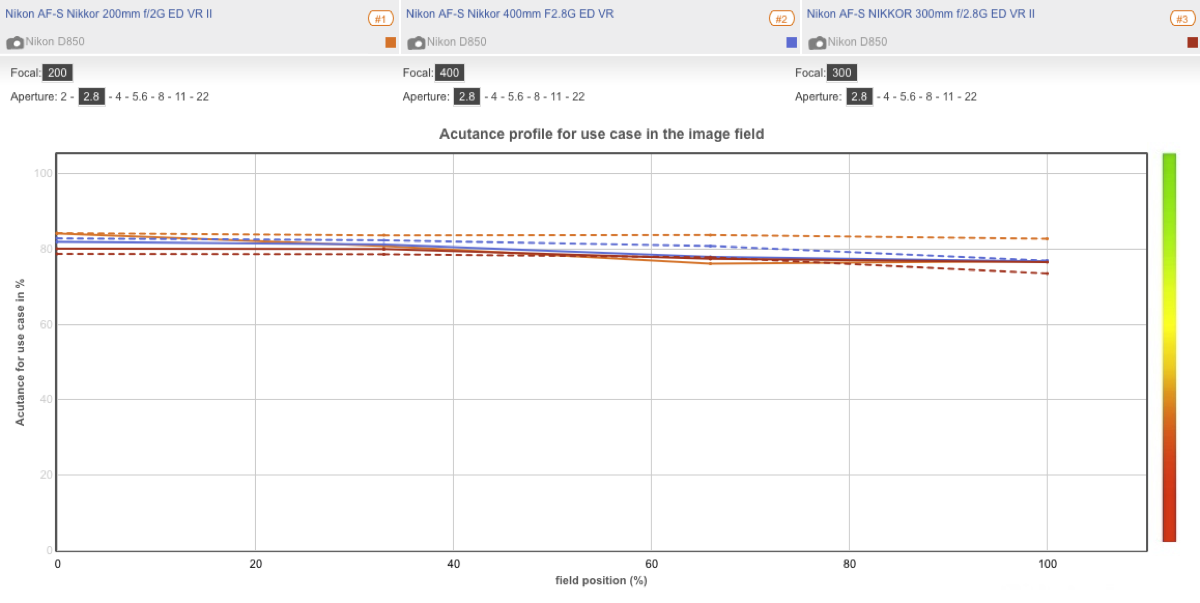
All three have low levels of lateral chromatic aberration (the 400mm F2.8 especially), minimal distortion (slight pincushion), and low levels of vignetting; and each one deviates by 0.4EV from its maximum aperture in terms of TStop.
Zoom lenses
Wide-angle zoom lenses
Third-party support isn’t as wide with zooms, as independents have tended to rally around APS-C, and the move to mirrorless is likely to stymie new models, at least for a while. The choice for full-frame models is therefore a little limited, but D850 owners are likely to have the Nikkor 14-24mm F2.8G in their sights. Introduced in 2007, this lens still dominates our database for its excellent optical quality. However, it’s now ranked in joint first place with the Tamron SP 15-30mm F2.8. With stabilization, it has good specs and is an accessibly-priced alternative. The Tamron doesn’t have the quite same range at the shorter end—which makes a difference at this focal length—but it’s a great performer. The next three in our database share a similar level of optical quality, though the Sigma 12-24mm F4 DG Art series is arguably the closest contender to the Nikkor 14-24mm in terms of overall capability
Since its introduction, the Nikkor 14-24mm F2.8G has enjoyed an enviable reputation as the ultra-wide zoom that others have to match. In many respects, we’ve never really seen another that does that, but there are others that have come close. While as we’ve already said the Tamron SP 15-30mm F2.8 doesn’t have quite the coverage at the wide end, it can match the Nikkor in overall optical quality and has higher peak sharpness. We’ve also taken a look at the Sigma. With a f/4 maximum aperture it’s ideally meant to be used on a tripod, but the 12mm focal length is highly attractive not only for landscape but for architecture and especially interiors.
Wide open, the Tamron has high sharpness in the centers throughout the zoom range, but there’s astigmatism from the mid-zones outwards that increases progressively towards 15mm. Stopping down mitigates that, especially at mid and lower focal lengths, but the short end is where it will be judged. It’s a very good performer at f/4 and above. That’s the maximum aperture for the Sigma, and yet it performs exceptionally well even at 12mm, with very consistent and homogenous sharpness across the frame. Sharpness drops towards the longer end when wide open, but it has very high sharpness centrally at f/5.6. Edge performance improves as you zoom out to 12mm.
Like the Tamron, the Nikkor has quite noticeable astigmatism at the shorter focal lengths, increasing as you zoom in, but it’s not quite as heavy there. Overall sharpness at 14mm is very close to that of the Tamron at 15mm, which is why the Nikkor is still popular after all these years. Still, the Sigma can hold its own with its rivals at the shorter end, and it has similar levels of lateral chromatic aberration, as well as lower barrel distortion and vignetting.
Standard zoom lenses
Leading this category with a DXOMARK score of 38 is the rather unusual Sigma 24-35mm F2 DG HSM Art. At $1000, it’s not exactly cheap, but then how many zooms are there with that maximum aperture? Not many. Admittedly, the range is a little limited, but it has high peak sharpness and an impressive T2.2 aperture, so it’s going to be of interest to filmmakers as well. There’s good support from third parties for the popular 24-70mm F2.8 model, with Tamron and Sigma in the $1200-1300 bracket in second and third place, respectively. If you’re a Nikon diehard, then you’re in for around double that at $2400 (at introduction) for the latest E-version (electronically-controlled aperture)—and there’s no stabilization either. As this is written for Nikon users, we’re going to include it in our comparison, although it is in 7th place; even so, it’s still very close optically to the best in this category.
With high sharpness throughout the zoom range, the Tamron SP24-70mm F2.8 Di VC USD is the strongest performer of the three. Like a lot of zooms, regardless of brand, it’s a little weaker at the longer end but it is consistent across the frame. The Sigma performs similarly, but with quite high levels of astigmatism from the mid-zones out to the corners, it’s not quite as strong at 70mm.
The much pricier Nikon also has weaker performance at 70mm, with similar levels of astigmatism. Throughout much of the Nikkor’s range, with the exception of 35mm, there’s a sharp central core at f/2.8–f/4, but sharpness falls off considerably in the outer zones. By f/5.6, sharpness levels are very high over a much wider central area, but the corners remain well behind. It’s not until f/8 that the Nikkor is sharp across the frame.
The Nikkor lens also has high levels of lateral chromatic aberration, not just at 24mm in the corners like the other two but in the outer zones and corners up to 50mm. And while the Nikkor has the highest transmission of the three and slightly less vignetting, it also has the most barrel distortion at 24mm. Although it is a good performer overall, given Nikon’s rich optical heritage, it could have been great, but it is a little disappointing at that price.
Tele-zoom lenses
We have a total of 35 lenses in this category ranging from 28mm to 500mm (though not in a single model, we hasten to add) and costing from $196 all the way up to $6,999 in price. As you may well have guessed, the 70-200mm models feature strongly at the top of this category, as they’re mainly the choice of serious enthusiasts and professionals (and expensive as a result). The Sigma 120-300mm F2.8 DG OS HSM S is another likely to be of interest to professionals, particularly those working in sports journalism, where it would complement or even replace the 70-200mm and 300mm F2.8 lenses at the sidelines. Indeed, Nikon has recently introduced its own version, though we’ve yet to get one in the lab for a look.
We’ve put together a mix of zoom models here and discounted the Nikkor 70-200mm F2.8G, as it has been updated with a newer fluorite (FL) E-series model that likely outperforms everything in this category. Instead, we’ve kept the Tamron SP 70-200mm F2.8 Di VC USD model (even though that, too, has been superseded by a promising G2 version) and compared it with the Sigma 120-300mm F2.8 and the Nikkor 70-200mm F4G ED VR, which is still current at the time of writing.
It may be an old model now, but as the best-performing tele-zoom in our database, the Tamron SP 70-200mm F2.8 has high sharpness levels throughout the zoom range even when opened up to its maximum. It retains those high levels even at the longer end, which is a big ask for any zoom. It is admittedly sharpest at the middle lengths, but it’s a phenomenal performer. It does have a couple of shortcomings, tough: first is the relatively high astigmatism at wider apertures in the middle and outer zones; second is that it has the greatest deviation from the maximum F-stop at –0.4 EV, making it a T3.2; and third, it has the highest vignetting of the three lenses.
The slower Nikkor 70-200mm F4 may not have been updated to an E-series lens, but it’s an outstanding lens with a high peak sharpness of 34P-Mpix. It also has high sharpness wide open from 70 through 200mm, albeit with just a slight degradation in sharpness at the longer end, along with some astigmatism there. Still, it puts in an amazingly consistent performance. It has some weaknesses, though, including the highest distortion of the three, and it has higher levels of chromatic aberration than the Tamron. Although at first glance an outlier in this group, the Sigma is targeting the same audience as the Tamron. It has excellent sharpness at the shorter end of the zoom range, but it can also match that of the Tamron wide open at 200mm. At 300mm, sharpness is still very good, though stopping down a notch is needed to pull the corners up.
As usual, you can create your own comparisons and in-depth analyses using our interactive lens comparison tool.
The post The best lenses for the Nikon D850 appeared first on DXOMARK.
